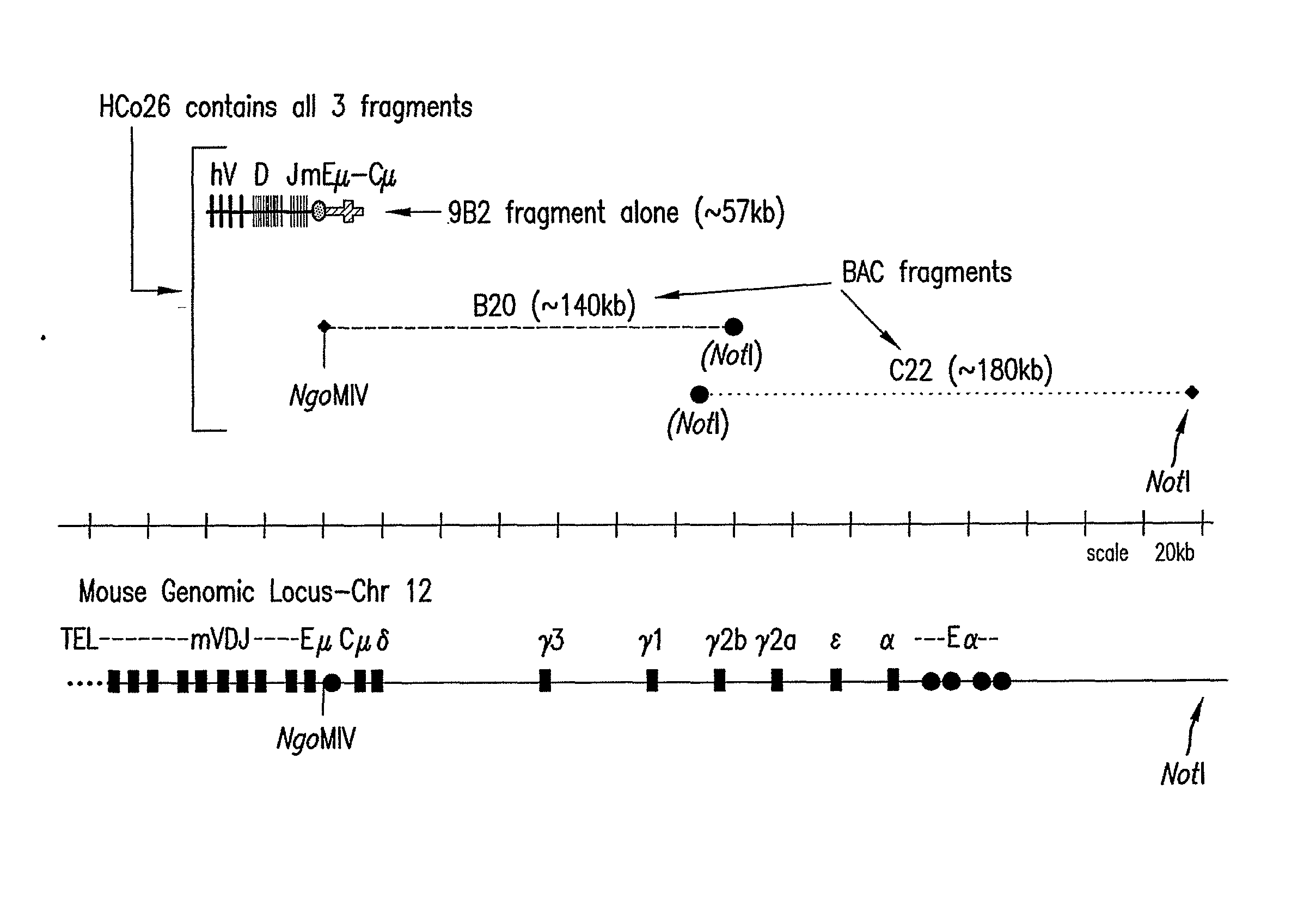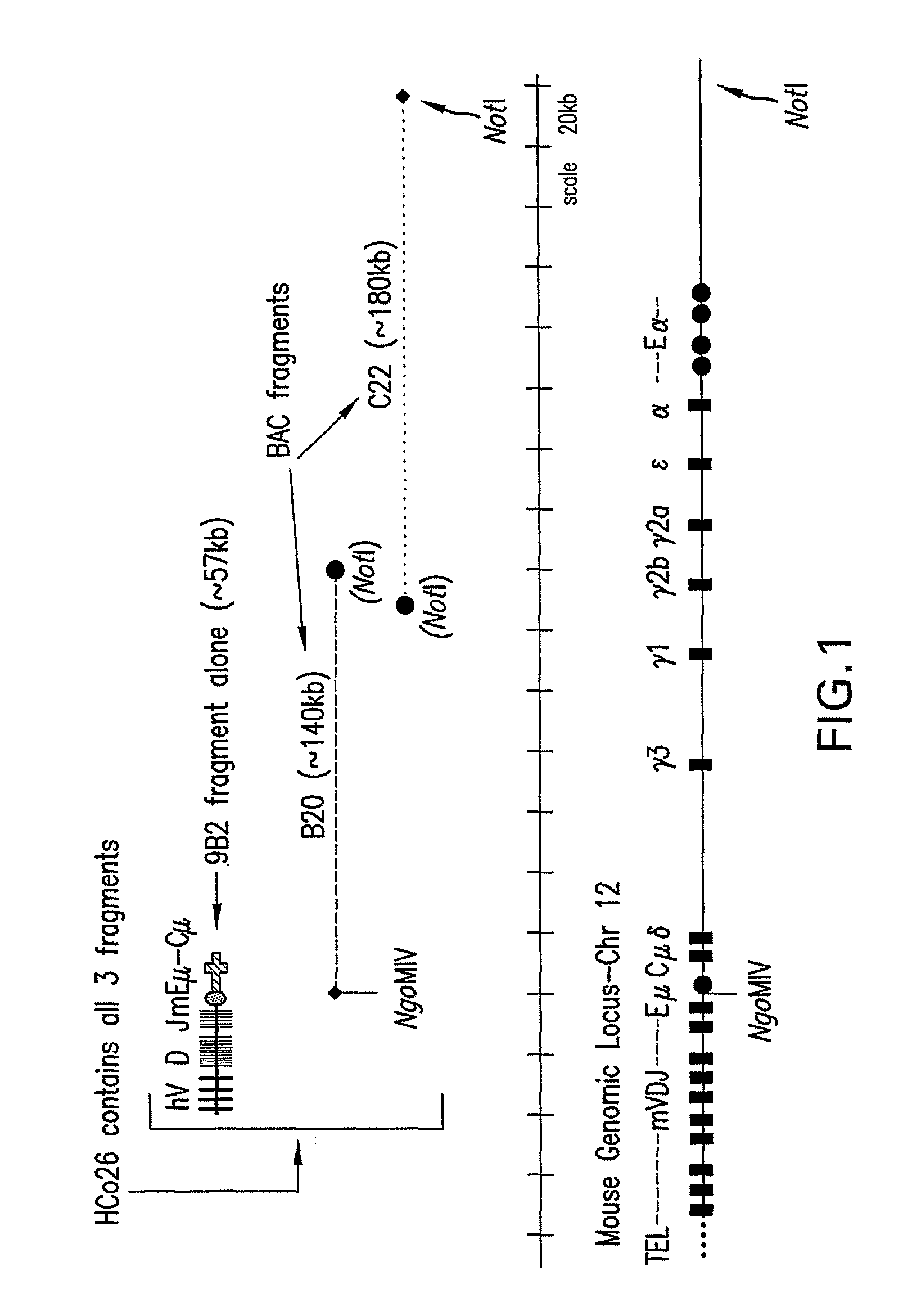Transgenic animals expressing chimeric antibodies for use in preparing human antibodies
- Summary
- Abstract
- Description
- Claims
- Application Information
AI Technical Summary
Benefits of technology
Problems solved by technology
Method used
Image
Examples
example 1
Construction of a Chimeric Transgene For Expressing Chimeric Antibodies Comprising Human VH and Mouse CH Regions
[0083]A transgene construct was prepared that contained unrearranged human heavy chain VDJ segments linked to the mouse Jμ enhancer region, μ switch region and μ coding region, as follows.
[0084]Intermediate Vectors
[0085]The intermediate vector pGP2-1 was constructed by digesting the previously described pGP2b with NotI, releasing the polylinker and ligating with a synthetic linker constructed by annealed overlapping oligos DMTM12 (5′-GGCCGCACGCGTGTC GACTC-3′) (SEQ ID NO: 1) and DMTM13 (5′-GCCGAGTCGACACGCGTGC-3′) (SEQ ID NO: 2). The resulting pGP2-1 plasmid then has a polylinker with a NotI site followed by a MluI, and a SalI site. The orientation and linker sequence were confirmed by sequencing.
[0086]The intermediate vector pIM-m2 was constructed by digesting the previously described pGP1b with NotI, releasing the polylinker and ligating with a synthetic linker constructed...
example 2
Preparation and Screening of Transgenic Mice
[0094]The approximately 57 kb NotI-SalI fragment from clone 9B2 of phVDJ-mEM (described in Example 1) was released from the vector and isolated by PFGE. An agarose gel slice with the 9B2 insert was excised and the agarose was digested with β-agarase (Takara) according to the manufacturer's protocol. The 9B2 fragment was micro-injected (by standard methods) into fertilized oocytes. DNA was injected into F1 mice of wild type (JHD− / − CMD− / −, JKD− / −, KCo5−)×KCo5 mice (JHD− / −, CMD+ / +, JKD+ / +, KCo5+ / +). Potential founder mice were screened for the 9B2 transgene by PCR with DMTM79 and DMTM80 using tail DNA as template. There were 4 resulting founder mice (9B2-52, 9B2-56, 9B2-58, and 9B2-65) on the JHD− / −, CMD+ / −, JKD+ / −, KCo5+ / − strain background.
[0095]Since mice of the CMD+ / − genotype still carry the endogenous mouse heavy chain J region, it was desirable to breed these founder mice with mice carrying the JHD deletion to obtain mice of the genot...
example 3
Characterization of Transgenic Mice Expressing Chimeric Antibodies
[0098]In this example, the antibody responses of the four transgenic mice founder lines described in Example 2 to tetanus toxoid (TT) and Interferon-α (IFN-a) were examined to identify mice expressing high levels of antibodies in which a human kappa light chain was paired with a heavy chain having a mouse IgG constant region, indicating that the heavy chain used in the antibody was derived from the transgene construct that had undergone rearrangement and trans-switching with the endogenous mouse IgG constant region.
[0099]Tetanus Toxoid Responses
[0100]The antibody responses to TT for the four 9B2 mouse lines were examined as follows. Five or six mice of each strain, consisting of four to five transgenic positive mice and at least one non-transgenic (ntg) mouse for use as a negative control, were challenged weekly with TT at 50 μg of TT in 100 μl total volume of RIBI adjuvant for four weeks. Sera were titered for mouse ...
PUM
| Property | Measurement | Unit |
|---|---|---|
| Temperature | aaaaa | aaaaa |
| Temperature | aaaaa | aaaaa |
| Temperature | aaaaa | aaaaa |
Abstract
Description
Claims
Application Information
 Login to View More
Login to View More - R&D
- Intellectual Property
- Life Sciences
- Materials
- Tech Scout
- Unparalleled Data Quality
- Higher Quality Content
- 60% Fewer Hallucinations
Browse by: Latest US Patents, China's latest patents, Technical Efficacy Thesaurus, Application Domain, Technology Topic, Popular Technical Reports.
© 2025 PatSnap. All rights reserved.Legal|Privacy policy|Modern Slavery Act Transparency Statement|Sitemap|About US| Contact US: help@patsnap.com


